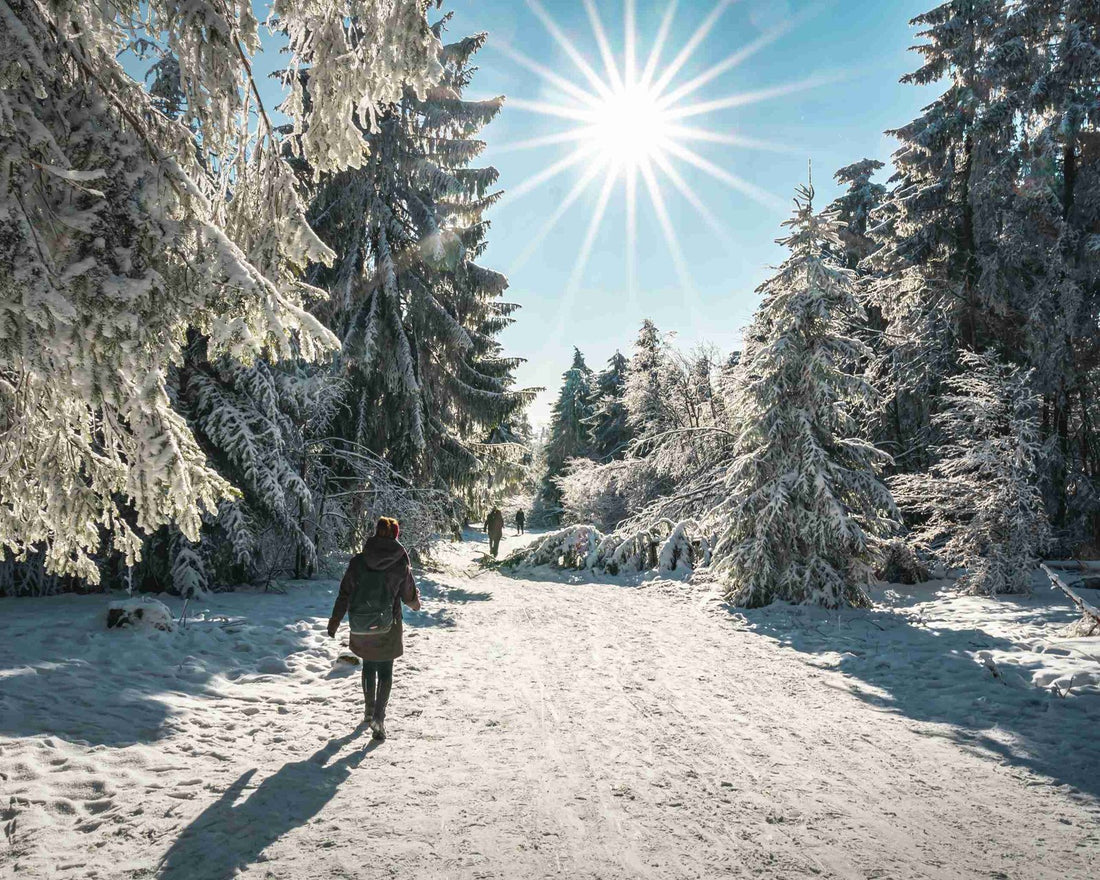
Navigating Winter Trails: 5 Tips for a Safe and Magical National Park Adventure
As winter blankets the landscape in a serene hush, national parks transform into enchanting wonderlands, inviting intrepid hikers to embark on a unique adventure. Crisp air, snowy trails, and the promise of untouched beauty make winter hiking an experience like no other. In this guide, we unveil the secrets to navigating the frosty trails of national parks with five essential tips for a safe, magical, and memorable winter hiking journey.
Winter hiking is a mesmerizing exploration, where familiar trails don a new guise, offering a fresh perspective on the pristine beauty of nature. As temperatures drop and snowflakes descend, the wilderness takes on an ethereal charm, calling forth those eager to witness the transformation.
Our journey begins with the fundamental importance of staying informed. The winter terrain is unpredictable, with snow, ice, and varying temperatures creating challenges for even the most seasoned hikers. Before setting foot on the trail, a thorough check of trail conditions and weather forecasts is essential. National parks, with their rugged landscapes, each present a unique winter canvas, and understanding these conditions ensures a safer and more enjoyable trek.
As we delve deeper into the guide, we uncover the art of dressing for winter success. Layering becomes a crucial strategy, from moisture-wicking base layers that manage sweat to insulating mid-layers providing warmth, and finally, a waterproof outer layer to shield against the elements. The right attire transforms winter hiking from a chilly expedition to a cozy and comfortable exploration.
Join us on this exploration of winter trails, where we’ll uncover the magic of winter wonderlands and share insights on essential gear, daylight considerations, and the importance of sharing your hiking plans for added safety. Whether you’re a seasoned hiker or a nature enthusiast, embrace the chill and let the snowy trails of national parks become your winter playground.
Navigating Winter Trails: Tip 1 – Stay Informed for a Seamless Journey
Embarking on a winter hiking adventure in national parks requires a strategic approach, beginning with staying well-informed about trail conditions and weather forecasts. The winter season introduces a dynamic and ever-changing environment, with snowfall, icy patches, and temperature fluctuations shaping the trails. To ensure a seamless and enjoyable journey, the first tip in our guide is to prioritize staying informed.
National parks provide a wealth of information to assist hikers in making well-informed decisions. Before setting out on the trail, visit the park’s official website or contact the visitor center for the latest updates on trail conditions. This includes information on snow accumulation, potential hazards, and any closures that might be in effect due to weather-related concerns.
In addition to official park channels, consult local weather forecasts for the specific area you plan to explore. Knowing the expected temperature range, snowfall predictions, and potential weather shifts during your hike will aid in preparing appropriately. Winter weather can be unpredictable, and being armed with up-to-date information ensures you are equipped to face the elements.
A mindful hiker is a prepared hiker, and this tip lays the foundation for a successful winter trek. By understanding the current conditions, you can tailor your clothing choices, gear selection, and overall approach to match the challenges posed by the winter landscape. Whether it’s navigating icy sections or being aware of potential avalanche risks, staying informed is key to a safe and rewarding winter hiking experience in national parks. As the first snowflakes fall, let your journey begin with the confidence that comes from being well-informed and ready to embrace the beauty of winter trails.

Embrace the Chill: Tip 2 – Bundle Up in Layers for Ultimate Comfort
As winter’s icy fingers weave through the landscapes of national parks, dressing appropriately becomes a crucial element for an enjoyable and comfortable hiking experience. Tip number 2 in our winter hiking guide focuses on the art of layering – a key strategy to embrace the chill while ensuring ultimate comfort on the trails.
Winter temperatures can be unforgiving, ranging from crisp and cool to biting cold, and as a hiker, preparing for these fluctuations is essential. The concept of layering involves strategically wearing different types of clothing to manage body temperature, moisture, and protection against the elements.
The layering process begins with a moisture-wicking base layer, designed to pull sweat away from your body and keep you dry. This foundational layer helps regulate body temperature by preventing the accumulation of moisture, which can lead to discomfort and even hypothermia in colder conditions.
On top of the base layer, add insulating layers to trap and retain body heat. This could include fleece or down jackets that act as a thermal barrier, providing warmth in the chilliest of environments. The thickness of these insulating layers can be adjusted based on the anticipated temperature and your personal comfort preferences.
To shield against wind, rain, or snow, the outer layer should be both waterproof and windproof. This protective shell serves as a barrier against the elements, ensuring you stay warm and dry throughout your hike. Waterproof boots, insulated gloves, and a snug hat are additional accessories that complete the ensemble, offering extra protection to extremities that are susceptible to cold.
By mastering the art of layering, you not only shield yourself from the winter’s bite but also ensure adaptability to changing weather conditions. Winter hiking becomes an enjoyable endeavor when you’re snugly wrapped in layers, ready to face the chill while reveling in the pristine beauty of national parks in their snowy splendor. As you hit the trails, let comfort be your companion, and may the layers you wear be as versatile as the winter landscapes you explore.

Crunchy Snow and Crisp Air: Tip 3 – Pack Winter-Specific Gear for Every Scenario
As winter weaves its magic across the trails of national parks, the landscape transforms into a snowy haven, inviting adventurers to explore its serene beauty. Tip number 3 in our winter hiking guide emphasizes the importance of packing winter-specific gear, ensuring you are well-equipped to navigate every scenario that the frosty wonderland may present.
Winter hiking introduces unique challenges that demand specialized gear to enhance safety and enjoyment. Traction devices, such as microspikes or crampons, become invaluable companions when navigating icy trails. These devices provide the necessary grip, preventing slips and falls on frozen surfaces, and ensuring stability with every step.
For trails buried under a blanket of deep snow, snowshoes become essential gear. These ingenious tools distribute your weight, preventing you from sinking into the snow with each stride. Snowshoes not only make hiking in deep snow more manageable but also open up a world of winter wonderland exploration that might otherwise be inaccessible.
Navigation tools, such as a map and compass or a GPS device, take on heightened importance during winter hikes. Snow-covered landscapes may obscure trail markers, and having reliable navigation aids becomes crucial for staying on course. Familiarize yourself with the trail beforehand and keep these tools easily accessible.
In the realm of hydration, insulated water bottles prove to be winter warriors. Freezing temperatures can turn your water supply into a block of ice, rendering it useless. Insulated bottles help prevent liquids from freezing, ensuring you stay hydrated throughout your winter trek.
Preparedness is the key to unlocking the magic of winter trails, and packing the right gear sets the stage for a seamless and enjoyable adventure. As you venture into the crisp air and crunch through the snowy landscape, let your winter-specific gear be your trusted companions, ready to tackle the challenges and enhance the beauty of every winter scenario you encounter.

Frozen Trails, Warm Hearts: Tip 4 – Mind the Daylight and Plan Accordingly
In the heart of winter, when the sun casts long shadows on the snow-covered trails of national parks, tip number 4 in our winter hiking guide emerges as a guiding light: mind the daylight and plan your adventure accordingly. As the days are shorter and the nights are longer, a well-thought-out plan ensures a safe and memorable journey through the winter wonderland.
Winter’s embrace brings with it a magical quality to the trails, but the reduced daylight hours require hikers to be mindful of their time on the paths. Starting your winter hike early in the day becomes not just a preference but a strategic decision. The sun, casting a warm glow on the frosted landscape, presents an opportunity to savor the beauty of the winter trails and maximize the available daylight.
Planning your hike with an awareness of the limited daylight is not only about chasing the sun; it’s about ensuring a safe return before the winter night blankets the trail in darkness. Winter conditions can slow your pace, from navigating through snow to adjusting for icy patches, making it crucial to allocate extra time for your journey.
Beyond the enchanting visuals, winter trails take on a different character as the sun descends. A well-planned winter hike allows you to witness the transition from daylight to the serene stillness of a winter night. It’s a chance to marvel at the stars as they twinkle overhead, unobscured by the city lights.
Whether you’re an early riser eager to catch the first light or a sunset enthusiast reveling in the golden hues of winter afternoons, planning your hike with the changing daylight in mind ensures that your winter adventure is not only visually captivating but also safe and well-paced. As you tread the frozen trails, let the awareness of daylight guide your steps, and may the warmth of your heart match the chill of the winter air.
Winter Wilderness: Tip 5 – Share Your Plans for Added Safety
As the crisp winter air blankets the trails of national parks, tip number 5 in our winter hiking guide emphasizes a crucial aspect of safety and camaraderie: share your plans before venturing into the winter wilderness. In the silent majesty of snow-covered landscapes, communication becomes a beacon of security, ensuring that your winter adventure unfolds smoothly and that a helping hand is always within reach.
Informing someone trustworthy about your hiking plans is not merely a precaution; it’s a proactive step towards enhancing safety on the trail. Share details such as the specific trail you intend to explore, your estimated time of departure, and the expected duration of your hike. This simple yet vital step ensures that there is someone aware of your whereabouts and timeline in case of unforeseen circumstances.
In the winter wilderness, conditions can change rapidly, and unexpected challenges may arise. By sharing your plans, you provide a safety net, enabling prompt assistance if needed. Should you encounter difficulties, from sudden weather changes to unexpected trail obstacles, knowing that someone is aware of your plans adds an extra layer of security and expedites help if required.
Technology further aids in communication on the winter trail. Carry a fully charged cellphone and, when possible, maintain a signal. Though remote areas may limit connectivity, having a means of communication can be invaluable in emergencies or for providing updates on your progress.
Sharing your plans is not just a safety measure; it fosters a sense of community among outdoor enthusiasts. The winter wilderness, with its serene beauty and untouched landscapes, becomes a shared experience. Conversations around winter hikes, recommended trails, and shared excitement create a bond that transcends the individual journey.
As you embark on your winter adventure, enveloped by the tranquility of snow-laden trees and the crunch of icy trails beneath your boots, remember that sharing your plans is an act of responsibility and community. Let the winter wilderness be a place of shared joy and shared safety, where the beauty of nature is complemented by the warmth of shared intentions.
